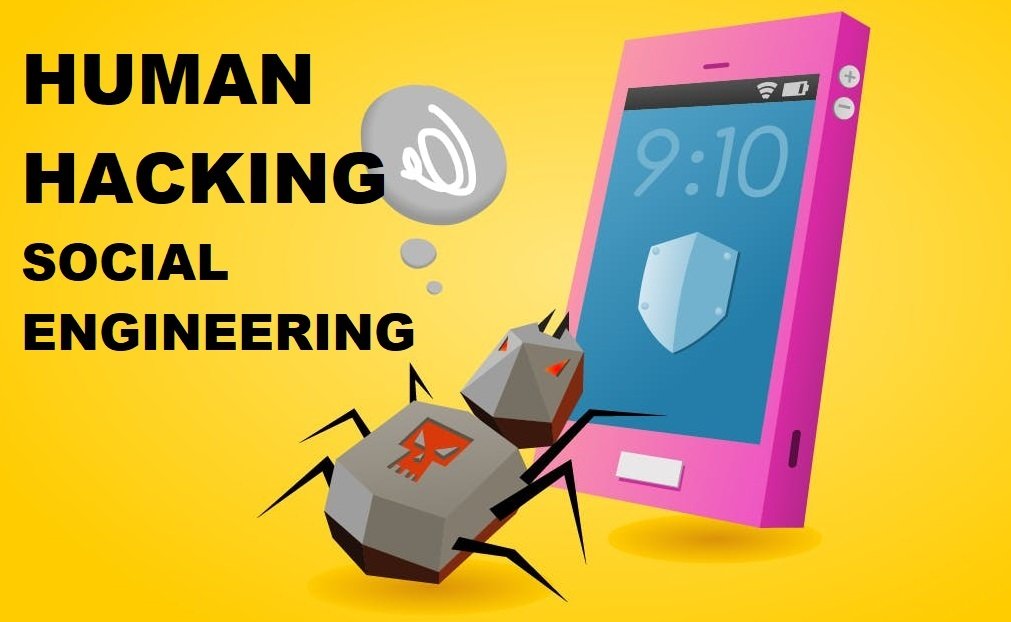Social Engineering: Exploiting Humans, The Weakest Link in Cybersecurity
In social engineering, people with malicious intent try to exploit human error to get private information, access, and valuables. The hackers use “human hacking” scams to let the victims (humans) themselves share all the sensitive information, spreading malware, and granting access to restricted systems without letting them know. Cybercriminals carry out attacks online, in person, or through other methods. These types of scams aim to manipulate people’s behavior by manipulating how they think and act. A user’s actions can be deceived and manipulated effectively once an attacker knows what motivates or trigger them. As a result of the rapid pace of technology, many employees and consumers are unaware of threats like drive-by downloads. Hackers use this knowledge to exploit consumers’ ignorance.
What is Social Engineering
This form of malicious activity using psychological manipulation techniques to trick end users into committing security mistakes or disclosing sensitive information. Social engineering refers to all those kinds of malicious activities that involve human interaction. Attacks based on social engineering follow a series of steps. As a first step, a perpetrator researches the intended victim to collect information about potential entry points and weak security protocols, to launch an attack. After gaining the victim’s trust, the attacker takes steps to undermine security practices, including revealing sensitive information or providing critical access. In addition to human error, social engineering relies on exploits in application software and operating systems, rather than on vulnerabilities in any kind of application software, utilities or operating systems.
Consequently, it is harder to identify malicious activity than identifying malware.
Social Engineering Attack Traits
Attackers use persuasion and confidence to manipulate their victims. When any user gets exposed to these tactics, he or she is more likely to act in ways one might not normally act. These characteristics are not always true. In some cases, attackers gain access to networks or computers using simpler methods of social engineering. Hackers, for example, may frequent a large office building’s public food court and “shoulder surf” laptops or tablets. It is also easily possible to get a huge number of passwords and usernames or other sensitive credentials without even sending an email or writing a virus code. Social engineering is commonly used in the following ways:
- Emotions: In any interaction, attackers can manipulate your emotions to give them an advantage. Emotions are used equally in order to persuade any person that triggers them to take irrational or risky actions.
- Urgency: It is also common for attackers to use time-constraint opportunities or requests to compromise themselves. Taking a scenario of an urgent problem that requires immediate attention, user might be motivated to compromise himself/herself. In addition, user may have to pay a prize that will disappear if he/she don’t act quickly, which may obliterate the ability to think critically.
- Trust: As a social engineering attack is ultimately a lie, credibility plays an important role. Your attacker has researched user enough to construct a narrative that is easy to believe and unlikely to raise suspicion.
Techniques used in Social Engineering
Here are five of the most popular known social engineering attacks. Social engineering attacks can occur anywhere there is human interaction.
Baiting Attack
The baiting attack uses a false promise technique to provoke a victim’s greed and curiosity. Baits are typically malware-infected flash drives, which are left in evident areas where potential target victims are very much certain to find them (e.g., bathrooms, elevators, a target company’s parking lot). They steal personal information or infect a victim’s system with malware. It is the one of the most abusive form of baiting.
There is a label on the bait that presents it as the payroll list of the company, which makes it seem authentic. Out of curiosity, the victim picks the bait up and inserts it into their work or home computers, resulting in the installation of malware. Baiting scams do not necessarily have to take place in person. Online baiting consists of enticing ads that direct users to malicious websites or to download malware-infected software.
Scareware
Rogue scanner software, False alarms and fictitious threats are used to scare victims with scareware. Scareware is also known as deception software, and fraudware. Users are tricked into believing that their device is infected with any kind of malicious software, which prompts them to install software that offers no real benefit (other than for the perpetrators).
When browsing the web, you often see legitimate-looking popup banners showing you that your device has been infected with spyware threats and programs. A typical example of scareware is popup banners that appear in your browser and say, “Your computer has been infected with spyware.” You can choose to either have the tool installed for you (often malware-infected) or to go to a malicious website where your device is infected. Spam emails also distribute scareware, which offers users worthless/harmful services or does not deliver on time.
Pretexting
This scam involves an attacker obtaining confidential information from a target user by using cleverly crafted lies. The perpetrator usually initiates the scam by posing as if they are in need of sensitive information. In most cases, the attacker begins by impersonating coworkers, police, and bank officials with the right to know authority.
Through the use of pretexters, key personal information is collected, such as personal addresses, phone numbers, social security numbers, staff vacation dates, security, bank records details, which are ostensibly required to verify the victim’s identity. This scam collects a lot of information and records, including social security numbers, addresses and phone numbers, call records, and even bank accounts.
Phishing
The phishing scam is a social engineering attack in which victims are induced to feel a sense of curiosity, pleasure, urgency, or fear by email or text message. Upon clicking on a link to some malicious website, or opening an attachment that contains malware, it tricks them into telling sensitive information. For example, an email may inform online service users that they have violated a policy and must change their password immediately.
As the user enters the credentials and other passwords, it prompts them to visit an illegitimate website that looks nearly identical to its legitimate version. As soon as the form is submitted, the attacker receives the information. Since phishing campaigns send identical, or nearly identical, messages to all users, mail servers with access to risk and threat sharing platforms are much better equipped to detect and block them.
Spear phishing
During this scam, an attacker picks individuals or businesses that they want to target. To make their attack less clear, they tailor the messages they send based on the job positions, characteristics and contacts of their victims. The perpetrator has to put much more effort into spear phishing, which may take days, even weeks and months. They’re much harder to detect, and they’re more likely to succeed if they’re done correctly.
Using spear phishing, an attacker can impersonate an IT consultant and send e-mails to employees of an organization. In this message, recipients are fooled into thinking it is an authentic message because it’s worded and signed exactly like the consultant normally does. A link is provided in the message that directs recipients to a page with some malicious intent where the attacker captures their credentials and prompts them to change their passwords.
Tailgating/Piggybacking
When a person without authorization closely follows a person with authorization in a reserved area, tailgating occurs. In order to sneak in before the door closes, the malefactor takes advantage when the authorized person opens the door with his own verified badge. The act of piggybacking occurs when someone obtains permission to access a reserved area by deceiving an authorized employee.
Prevention from social engineering attacks
By manipulating human emotions such as curiosity, greed, pleasure or fear, social engineers are able to pull victims into their traps and carry out schemes. Whenever you receive an email that seems alarming, see an offer on a website that seems too good to pass up, or see any stray digital media lying around, be cautious. It is important to stay alert in order to avoid most of the social engineering attacks which are taking place over the internet. Additionally, the following tips will help you become more vigilant against social engineering attacks:
- Whenever you receive an email or attachment from an unknown source, do not open it: A question email does not need to be answered if you don’t know the sender. Even if you know the sender and are suspicious of the message, confirm the news by calling the service provider or visiting their website directly. Often, email addresses are spoofed; even emails that appear to come from trusted sources may actually be the work of an attacker.
- Authenticate using multiple factors: In the event that a system is compromised, multi factor authentication helps protect your account. User credentials are one of the most valuable set of sensitive information attackers seek.
- Beware of offers which are tempting: Think twice before accepting an offer that sounds too tempting. Whether you’re dealing with a legitimate offer or a scam can be determined quickly by Google the topic.
- You should keep your anti-virus and anti-malware software up-to-date: Regularly check to see that the updates have been installed, and also regularly scan your system for potential infections. Enable automatic updates, or make downloading the latest signatures a habit.
Conclusion
In order for all users to be protected against social engineering, we must educate them about the threats. By sharing what you’ve learned with your family, friends, and coworkers, you can contribute in helping people from getting scammed.


[…] post Social Engineering: Exploiting Humans, The Weakest Link in Cybersecurity appeared first on Computer Service […]
[…] post Social Engineering: Exploiting Humans, The Weakest Link in Cybersecurity appeared first on Computer Service […]
[…] post Social Engineering: Exploiting Humans, The Weakest Link in Cybersecurity appeared first on Computer Service […]
Comments are closed.